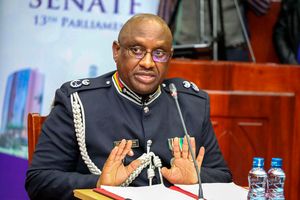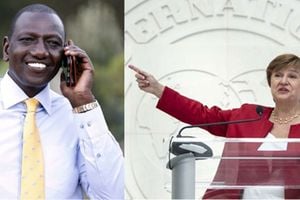Let’s ‘partner’ with wildlife

An elephant keeper gives enriched milk to a calf using a feeding bottle during a feeding routine early in the morning at Reteti Elephant Sanctuary in Namunyak Wildlife Conservancy, Samburu, Kenya on October 12, 2022.
What you need to know:
- The foundation of our health must be built upon the idea that taking care of the planet is to take care of ourselves.
- We must resist the notion that the people living with wildlife are forever destined to be victims of climate change.
The concept of having enough space — enough room — is familiar to society. We all recognise the impacts of inadequate space or the feeling of being limited by the environment around us.
Oftentimes, these limitations are physical; at other times, they are imposed by rules to keep humanity within certain boundaries.
The notion of ‘having enough room’ is equated with the space to flourish, room to thrive. But first, it is fundamental that biodiversity and wildlife be protected. They form the cornerstone of our own health and, perhaps surprisingly, the cornerstone of one of our greatest tools through which to mitigate the impact of climate change.
The recent inaugural Africa Climate Summit, in Nairobi, was a milestone. The first of its kind on the continent, it was an opportunity to show that African nations, people and landscapes hold many of the solutions the world desperately needs to address the climate crisis.
When we choose to protect biodiversity, we are, in essence, choosing to protect ourselves. This powerful concept may seem obvious to many at first but is, sadly, strikingly absent from the conversation of the day, overtaken almost exclusively by that about the reduction of fossil fuels. Although this is inherently an important step, it is not the only action to take.
The foundation of our health must be built upon the idea that taking care of the planet is to take care of ourselves. We must look at nature, and planet, through a different lens — recognising them as the key through which to save ourselves. As a ‘partner’.
Victims of climate change
Perhaps, this begins with the concept of ‘resistance’. We must resist the notion that wildlife is simply a victim of climate change. We must resist the notion that the people living with wildlife are forever destined to be victims of climate change.
The reality is that wildlife and their human neighbours are partners in the mitigation of climate change. And to continue to be effective partners in this global struggle, they must be healthy. Not simply healthy as a collective but individuals.
Healthy enough to lead fulfilling lives with predictable wellbeing and to be able to ensure the same for their offspring. To inspire hope today and for generations to come.
When those living with wildlife view themselves as healthy, only then will they consider themselves partners in saving the planet, helping to counteract the ravaging effects of climate change.
The notion that to save biodiversity is an ‘option’ is a death knell for us. Ironically, much of the conversation is focused on sustainable development goals when our goal must be sustainable existence. We are not even at the point of broaching the topic of ‘sustainability’ when our basic existence is in peril.
I do not believe we have reached the point of no return. Regardless of the negativity and escalating impacts that surround us, we must continue to have hope. It is not something that we cling to but rather something we embrace with full vigour. For the solution to the climate crisis lies in the protection of our biodiversity and its rich wildlife.
Nature will bounce back if we allow it to. If we give all our partners a seat at the table, if we allow nature to work its ‘magic’ (aka science) and if we give nature and wildlife the room it needs — the ‘room to roam’.
Room to Roam
Herein lies the foundation for an ambitious transnational initiative championed by IFAW in East and Southern Africa. “Room to Roam” is a visionary approach to overcoming climate change in Africa with people and elephants leading the way.
Its magic lies in its inherent simplicity, creating connectivity in conservation areas where humans and animals can thrive together in climate-resistant landscapes.
By linking, protecting and effectively managing critical habitats, the elephant can fulfill its role as an ‘ecosystem engineer’, transforming vegetation into a form of carbon that can be stored in the soil (that is, carbon sequestration), hence reducing the impact of climate change.
The elephants simply need space — room to roam. The connected corridors allow them to roam freely and safely but n a way that also allows humans to thrive through the conservation of the habitats and the resilient livelihoods they develop. The communities become the stewards of the elephants and wildlife, sharing space in harmony and continuing age-old coexistence.
This powerful nature-based solution must be at the forefront of our actions. Without such solutions, people are likely to be reluctantly forced into migration for survival. Malnutrition will ensue, and then human conflict. As a conservationist friend of mine wisely says, “Show me a broken people and I will show you a broken environment”.
Success ultimately rests on one fundamental question: Are we willing to share the earth with wildlife? If so, let’s embrace this transformative concept of biodiversity protection, where ecosystem and corridor connectivity lie at the centre lest we miss the desired healthy and biodiverse environment.
Mr Downes is the president and CEO of the International Fund for Animal Welfare





